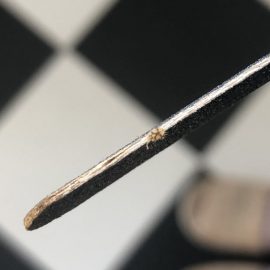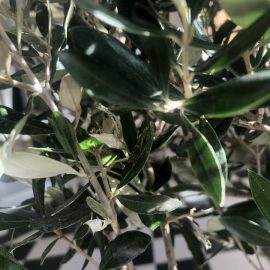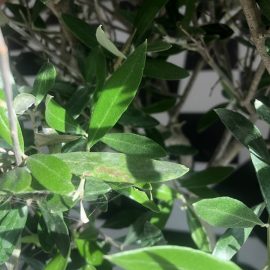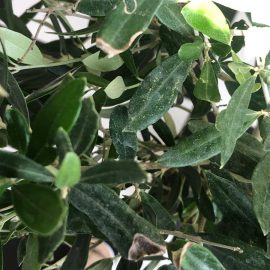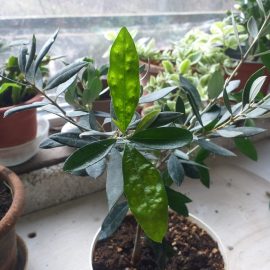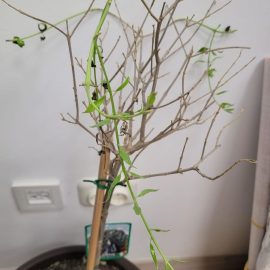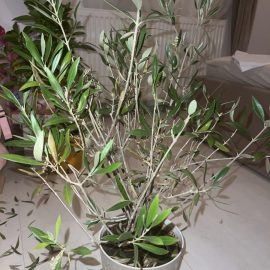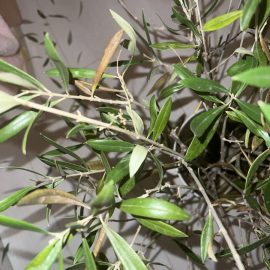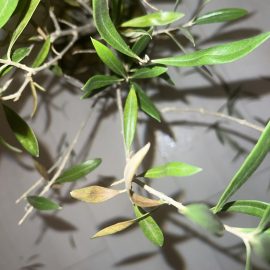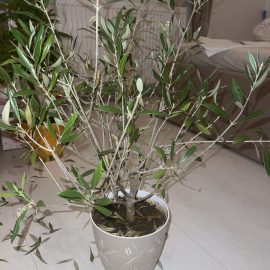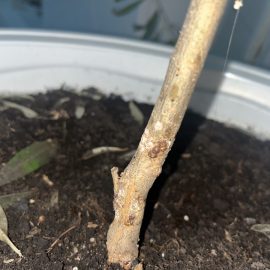Olive, plant care and growing guide
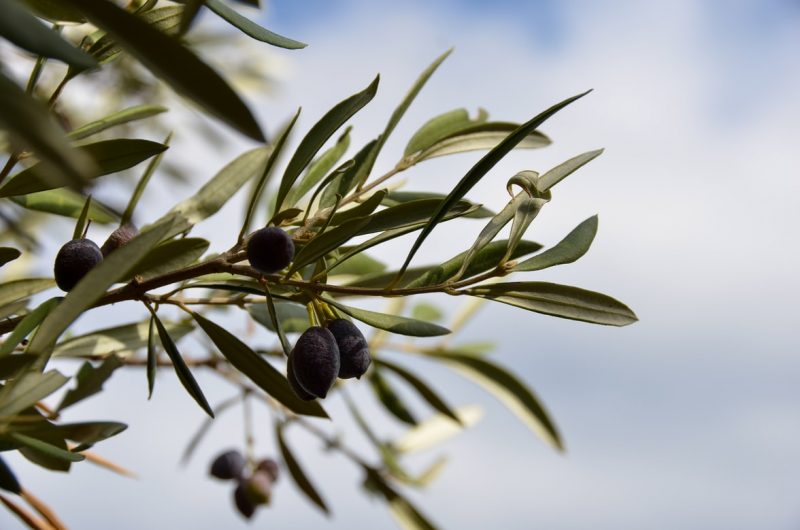
Olive (Olea europaea) is a species of small tree in the Oleaceae family. It is native to the Mediterranean Basin and the tropics of the Middle East. It is often used as an ornamental plant, in pots, indoors, or gardens and terraces, in summer. In the natural environment, it can grow up to 15 m. In pots, it reaches up to 1-1.5 m in height. The olive has evergreen leaves. It has an alternate leaf arrangement, the leaves being gray-blue, with a silver underside, almost white. The flowers are small, white, hermaphroditic. They grow in clusters at the base of the leaves.
The flowers appear in spring, only on branches older than one year. The fruits, known as olives, are round, elongated drupes with a single seed. They are green, in the beginning, while the ripe olives have a purple color. Olives have a special economic value in the Mediterranean area, representing the main source of oil (olive oil). Olives are also among the basic ingredients used in various Mediterranean dishes.
Species and varieties
Olea europaea is the only cultivated and exploited species, which includes numerous subspecies and cultivars. Other species of the genus Olea are known but are considered wild (Olea capensis , Olea oleaster, etc.).
Olea europaea var. sativa – it has small, whitish leaves. It blooms in May-June.
Olea europaea subsp. africana (cuspidata) – it forms small, dark fruits. The leaves are silvery-green, glossy on the topside.
Olea europaea ‘Leccino’ – is one of the main cultivars used for olive oil.
Olea europaea ‘Frantoio’ – it has a stronger aroma than ‘Leccino’ and it is also cultivated for the production of olive oil.
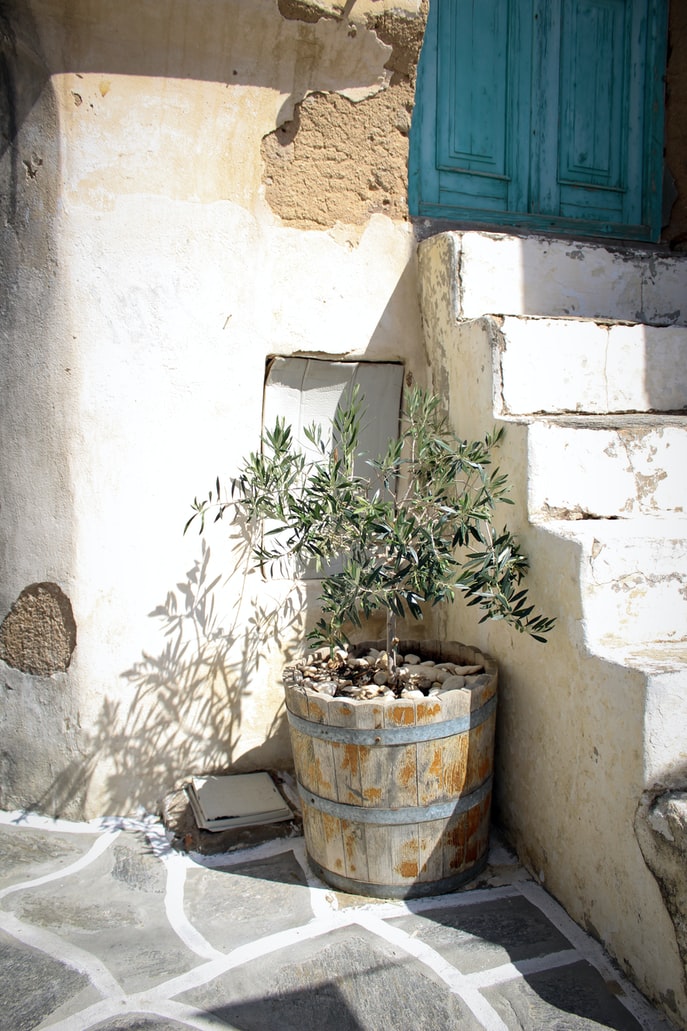
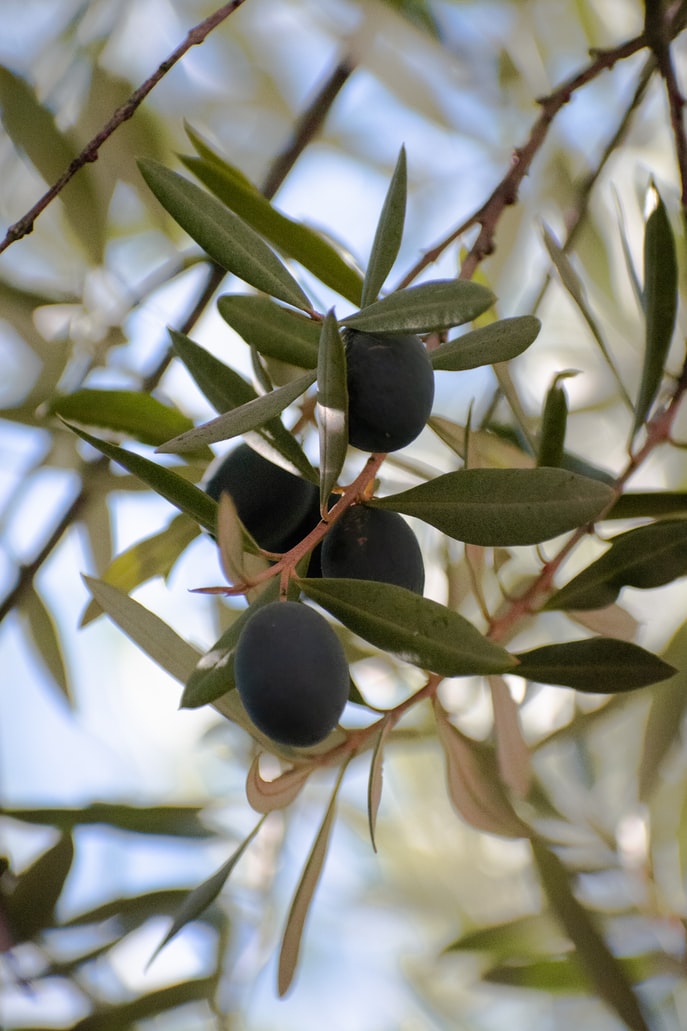
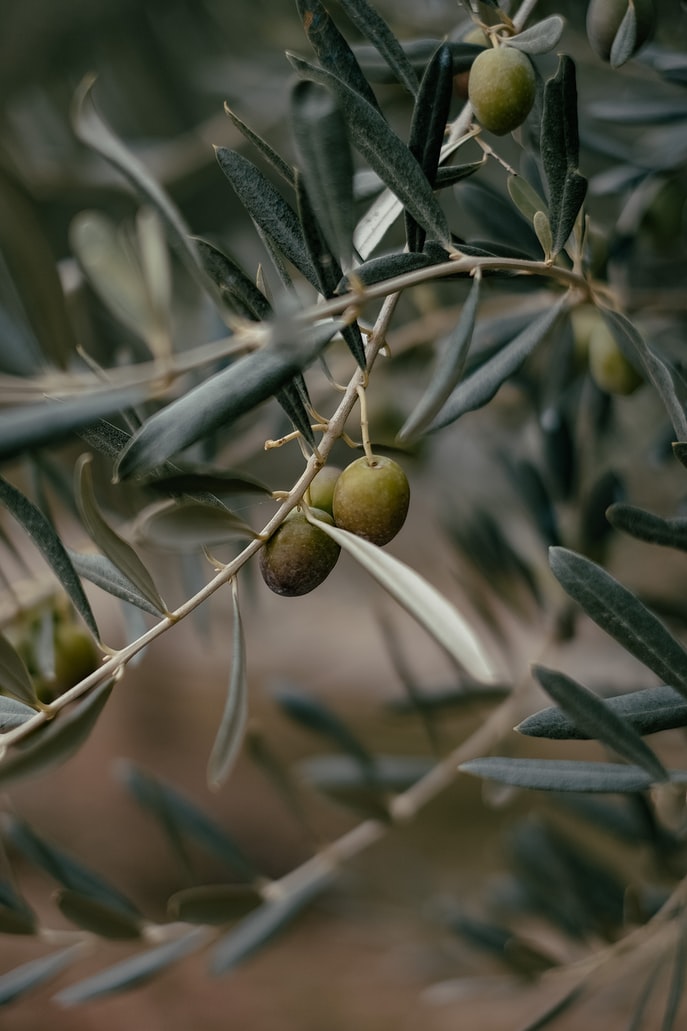
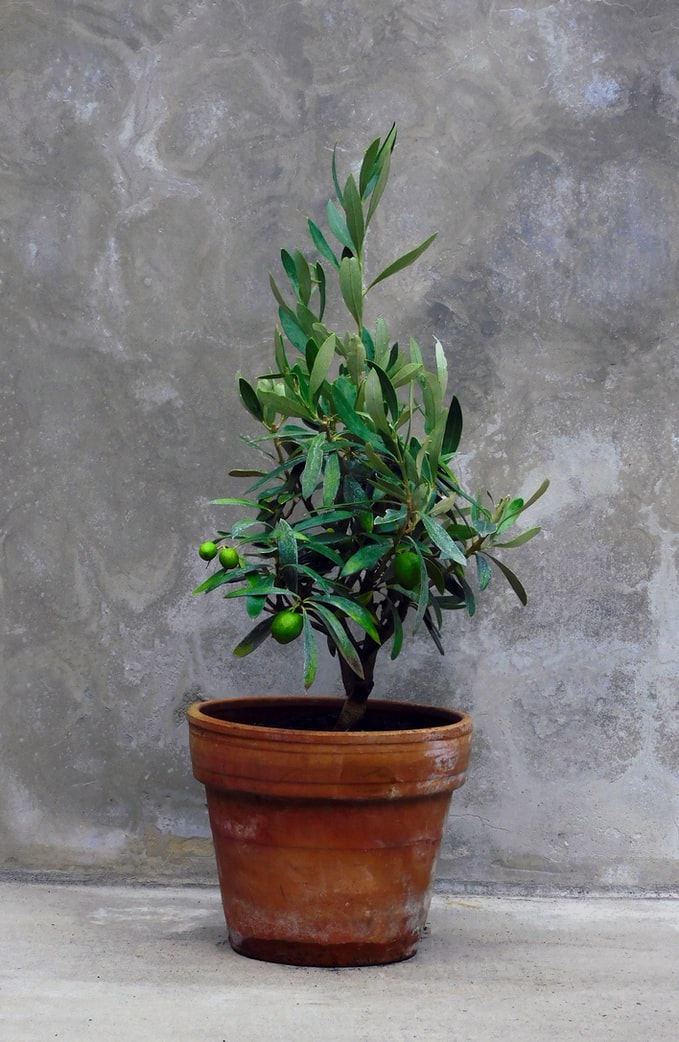
Environmental conditions
Light. The olive tree prefers bright places, with direct sunlight, but it also grows in partial shade.
Temperature. It needs an optimum temperature of about 20° C and it is affected by temperatures below 0° C. The specimens grown in pots outdoors, have to be protected during the winter.
Substrate. It prefers a substrate with peat content, garden soil, and sand, which allows good drainage. It optimally grows in a substrate for houseplants.
Recommended products
-
You can find products on a different store
Change Store -
You can find products on a different store
Change Store -
You can find products on a different store
Change Store -
You can find products on a different store
Change Store -
You can find products on a different store
Change Store -
You can find products on a different store
Change Store -
You can find products on a different store
Change Store -
You can find products on a different store
Change Store -
You can find products on a different store
Change Store -
You can find products on a different store
Change Store -
You can find products on a different store
Change Store -
You can find products on a different store
Change Store -
You can find products on a different store
Change Store -
You can find products on a different store
Change Store -
You can find products on a different store
Change Store -
You can find products on a different store
Change Store -
You can find products on a different store
Change Store -
You can find products on a different store
Change Store -
You can find products on a different store
Change Store -
You can find products on a different store
Change Store -
You can find products on a different store
Change Store -
You can find products on a different store
Change Store -
You can find products on a different store
Change Store -
You can find products on a different store
Change Store
Care
Watering. During the vegetative growth period, it should be watered regularly, so that the substrate in the pot is kept moist, but not too wet. In winter, the frequency of watering should be reduced, but the substrate must not be allowed to dry completely.
Fertilization. From March to September, a universal fertilizer should be administered.
Recommended products
-
You can find products on a different store
Change Store -
You can find products on a different store
Change Store -
You can find products on a different store
Change Store -
You can find products on a different store
Change Store -
You can find products on a different store
Change Store -
You can find products on a different store
Change Store -
You can find products on a different store
Change Store -
You can find products on a different store
Change Store -
You can find products on a different store
Change Store -
You can find products on a different store
Change Store -
You can find products on a different store
Change Store -
You can find products on a different store
Change Store -
You can find products on a different store
Change Store -
You can find products on a different store
Change Store -
You can find products on a different store
Change Store -
You can find products on a different store
Change Store -
You can find products on a different store
Change Store -
You can find products on a different store
Change Store -
You can find products on a different store
Change Store -
You can find products on a different store
Change Store -
You can find products on a different store
Change Store -
You can find products on a different store
Change Store -
You can find products on a different store
Change Store -
You can find products on a different store
Change Store
Transplanting. The Olive tree does not require repeated transplants, except in the case of replacing the pot with a larger one. In general, Olive trees are kept in large pots, and once every 2 years the soil on the surface should be replaced with a fresh substrate.
Pruning. Cleaning cuts are required every spring. Remove the dry branches and those inside the tree crown, to favor the penetration of light. Shape remedial cuts can be done in summer to stimulate stronger shoots.
Recommended products
-
You can find products on a different store
Change Store -
You can find products on a different store
Change Store -
You can find products on a different store
Change Store -
You can find products on a different store
Change Store -
You can find products on a different store
Change Store -
You can find products on a different store
Change Store -
You can find products on a different store
Change Store -
You can find products on a different store
Change Store -
You can find products on a different store
Change Store -
You can find products on a different store
Change Store -
You can find products on a different store
Change Store -
You can find products on a different store
Change Store -
You can find products on a different store
Change Store -
You can find products on a different store
Change Store -
You can find products on a different store
Change Store -
You can find products on a different store
Change Store -
You can find products on a different store
Change Store -
You can find products on a different store
Change Store -
You can find products on a different store
Change Store -
You can find products on a different store
Change Store -
You can find products on a different store
Change Store -
You can find products on a different store
Change Store -
You can find products on a different store
Change Store -
You can find products on a different store
Change Store
Propagation
Olive can be propagated through seeds or cuttings.
Recommended products
-
You can find products on a different store
Change Store -
You can find products on a different store
Change Store -
You can find products on a different store
Change Store -
You can find products on a different store
Change Store -
You can find products on a different store
Change Store -
You can find products on a different store
Change Store -
You can find products on a different store
Change Store -
You can find products on a different store
Change Store -
You can find products on a different store
Change Store -
You can find products on a different store
Change Store -
You can find products on a different store
Change Store -
You can find products on a different store
Change Store -
You can find products on a different store
Change Store -
You can find products on a different store
Change Store -
You can find products on a different store
Change Store -
You can find products on a different store
Change Store -
You can find products on a different store
Change Store -
You can find products on a different store
Change Store -
You can find products on a different store
Change Store -
You can find products on a different store
Change Store -
You can find products on a different store
Change Store -
You can find products on a different store
Change Store -
You can find products on a different store
Change Store -
You can find products on a different store
Change Store
Recommended products
-
You can find products on a different store
Change Store -
You can find products on a different store
Change Store -
You can find products on a different store
Change Store -
You can find products on a different store
Change Store -
You can find products on a different store
Change Store -
You can find products on a different store
Change Store -
You can find products on a different store
Change Store -
You can find products on a different store
Change Store -
You can find products on a different store
Change Store -
You can find products on a different store
Change Store -
You can find products on a different store
Change Store -
You can find products on a different store
Change Store -
You can find products on a different store
Change Store -
You can find products on a different store
Change Store -
You can find products on a different store
Change Store -
You can find products on a different store
Change Store -
You can find products on a different store
Change Store -
You can find products on a different store
Change Store -
You can find products on a different store
Change Store -
You can find products on a different store
Change Store -
You can find products on a different store
Change Store -
You can find products on a different store
Change Store -
You can find products on a different store
Change Store -
You can find products on a different store
Change Store
Diseases and pests
The pests that can infest Olive trees are European fruit lecanium or wooly apple aphids.
Olive trees can be affected by the fungus Spilocaea oleagina, whose symptoms are the appearance of black spots on the leaves, flowers, or fruits and premature leaf fall.
In addition:
- due to the cool climate of some countries, Olive trees sometimes do not form fruit or lose them prematurely.
- in general, the Olive has a slow growth.














































































































































































































































































































































































































































